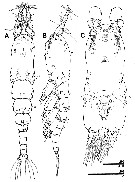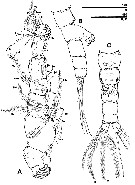|
|
 |
Fiche d'espèce de Copépode |
|
|
Monstrilloida ( Ordre ) |
|
|
|
Monstrillidae ( Famille ) |
|
|
|
Caromiobenella ( Genre ) |
|
|
| |
Caromiobenella polluxea Jeon, Lee & Soh, 2018 (M) | |
| | | | | | | Ref.: | | | Jeon & al., 2018 (p.51, Descr. M, figs.M, Rem.) |  Issued from : D. Jeon, W. Lee & H.Y. Soh in J. Crustacean Biol., 2018, , 38 (1). [p.54, Fig. 6] Male (from 34°26'43.3''N, 126°21'57.3''E): A, habitus showing crater-like depressions (arrows) and dorsal mound with 2 pairs of pores (hollow arrow); B, habitus (arrows indicate crater-like depressions), lateral view; C, cephalothorax with P1, ventral view (le = lateral eye; ve = ventral eye) Arabic numerals in A and B indicate pit-setae. Scale bars in µm. Nota: - Ratio of lengths of cephalothorax, metasome and urosome 38.6 (37.9-39.2) ; 38.1 (35.7-39.4) : 23.3 (21.7-25.1) in lateral view. - Pseudoral cone with no apical pore situated in anterior ventral region between antennular bases and oral papilla. - Dorsal medial half of cephalothorax slightly swollen, forming small mound with 2 pairs of pores. - Oral papilla low, located ventrally at 36.2 % (33.0- 39.2) of distance from anterior end of cephalothorax. - 2 lateral and 1 ventral eyes within anterior of forehead, moderately developed, pigmented; lateral eyes oval , 0.07 mm long, 0.06 mm wide, 0.05 mm apart across midline. Ventral eye round, smaller in diameter (0.05 mm) than lateral eyes. - Body somites from first free pediger to fourth free pediger with several pore pairs in various regions; 1st free pediger with 3 pairs of pit-setae posteriorly (n° 6-8: 2 pairs laterally, other pair dorsally) plus pair of simple pores anterior to dorsal pair of pit-setae. - Tergite of incorporated 1st pediger with 5 pairs of pit-setae: 1 pair situated dorsally (n°1), 4 pairs laterally (n°2-5) - Length of A1 in relation to total body length 28.7 % (27.9-29.7). - Branched setae absent, replaced by unbranched simple setae. - Each caudal ramus with 5 plumose setae, outermost 2 (I, II) coarsely bipinnate. All caudal setae subequal in length except for noticeably shorter dorsal seta VI.
|
 Issued from : D. Jeon, W. Lee & H.Y. Soh in J. Crustacean Biol., 2018, , 38 (1). [p.55, Fig. 7] Male: A, left A1 (dorsal view); B, urosome (lateral view); C, urosome showing genital opercular flaps (hollow arrows), medial protrusion (filled arrow), between lappets and asterisks on caudal rami indicate ventral pores, ventral view. Scale bars in µm Nota: - Genital shaft robust, 0.06 mm (0.064-0.066) long with genital opercular openings at distal end covered by 2 opercular flaps; pair of short, subtriangular distal lappets separated by posterior medial protrusion of shaft, each lappets with inner side corrugated, coarsely denticulate. - Ratios of A1 segment lengths (from p^roximal to distal) 16.7 (15.8-17.3) : 19.7 (18.4-20.4) : 16.6 (15.8-17.1) : 22.6 (21.2-23.7) : 24.3 (23.5-25.4). - Spine 6 on 5th segment of A1 naked. - Spinous elements on first 3 A1 segments biserrate along outer margin. 4d 1-2, 4v 3, relatively long, slender; spine 4v 1, 2 rather short, robust.
|
 Issued from : D. Jeon, W. Lee & H.Y. Soh in J. Crustacean Biol., 2018, , 38 (1). [p.56, Fig. 8] Male: 4-D, P1 to P4 (anteriorv views) showing plunging distal margin of intercoxal sclerites (filled arrows) and inner distal bulging of bases (hollow arrows), asterisks indicate anterior pores. Scale bar in µm. Nota: - Inner distal corners of protopods of P1 to P4 bulging. - Distal margin of intercoxalsclerites of all legs triangularly incised. - Outermost seta on 3rd exopodal segments of legs with dense serration along inner margin. - P5 absent, but at least 2 specimens out of 4, including holotype, with unilateral nipple-like protuberance on posterior ventral part of 1st urosomal somite (4th free pediger).
|
 Issued from : D. Jeon, W. Lee & H.Y. Soh in J. Crustacean Biol., 2018, , 38 (1). [p.58, Fig. 10] Male (paratypes): A, P1 showing bulging inner distal corner of basis (arrow), left, posterior; B, P3 joined by intercoxal sclerite (filled arrow) and showing bulging inner distal corner of basis (hollow arrow), posterior; C, genital apparatus showing posterior protrusion (arrow), ventral; D, opercular flaps (arrows) on distal margin of genital shaft, ventral. Scale bars in µm.
|
 Issued from : D. Jeon, W. Lee & H.Y. Soh in J. Crustacean Biol., 2018, , 38 (1). [p.57, Fig. 9, E-F] Male: E, 4th antennular segment with setal elements (left side, ventral view); F, 5th antennular segment armed with naked distalmost spine 6 1, right side, dorsal view). Scale bars in µm.
| | | | | NZ: | 1 | | |
|
Carte de distribution de Caromiobenella polluxea par zones géographiques
|
| | | | | | | Loc: | | | S Korea (Gogunmyeon)
Type locality: 34°26"43.3'' N, 126*21'57.3'' E. | | | | N: | 1 | | | | Lg.: | | | (1233)* M: 1,14-1,15 (mean = 1,14); {M: 1,14-1,15}
*: excluding the caudal rami . | | | | Rem.: | Collected by using a light trap from 20.00to 23.00 h.alongside a seawall (Yongho Seawall). | | | Dernière mise à jour : 17/09/2020 | |
|
|
 Toute utilisation de ce site pour une publication sera mentionnée avec la référence suivante : Toute utilisation de ce site pour une publication sera mentionnée avec la référence suivante :
Razouls C., Desreumaux N., Kouwenberg J. et de Bovée F., 2005-2025. - Biodiversité des Copépodes planctoniques marins (morphologie, répartition géographique et données biologiques). Sorbonne Université, CNRS. Disponible sur http://copepodes.obs-banyuls.fr [Accédé le 20 octobre 2025] © copyright 2005-2025 Sorbonne Université, CNRS
|
|
 |
 |







